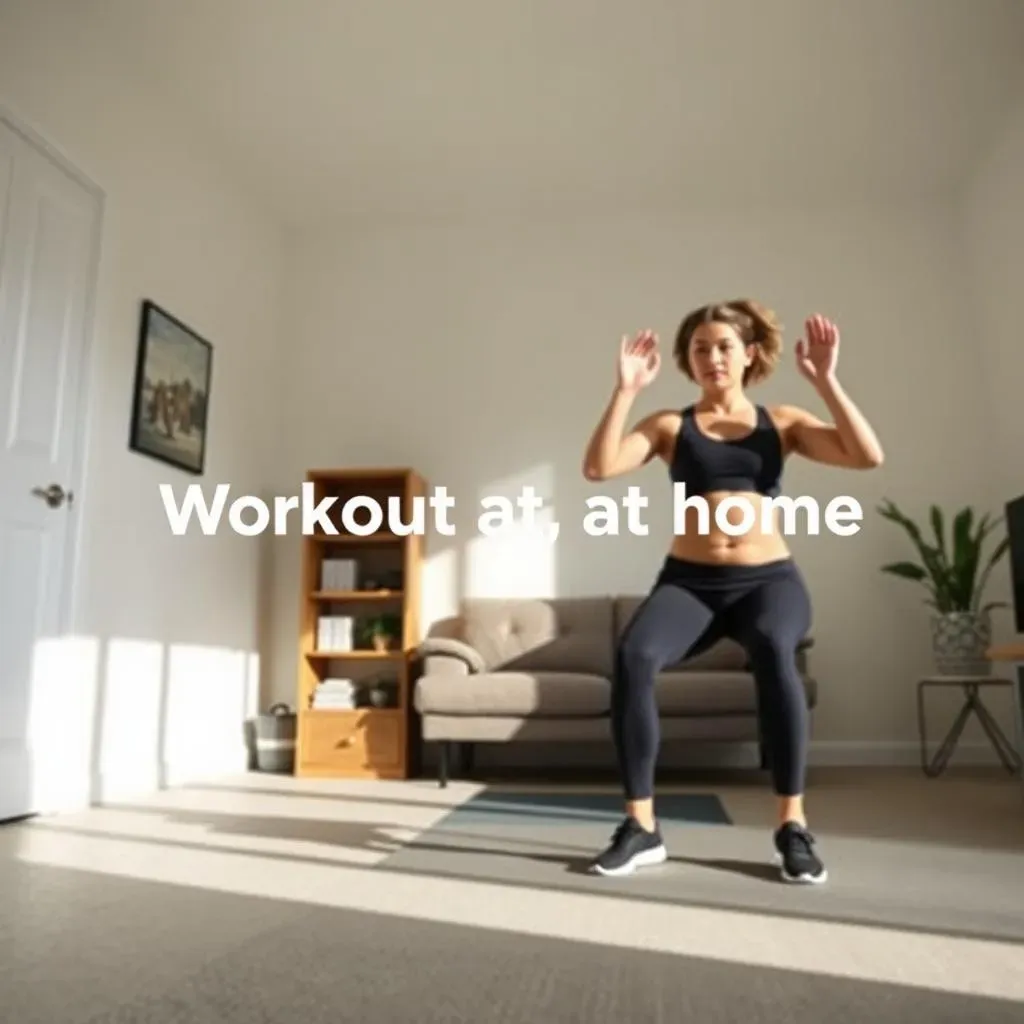Table of Contents
Ready to sculpt your dream body without stepping foot in a gym? This guide is your passport to achieving a toned physique through the power of HIIT workouts at home. Forget expensive equipment and complicated routines; we'll show you how to harness the incredible fat-burning and muscle-building benefits of high-intensity interval training (HIIT) right in your living room. We'll start by guiding you through the essentials of getting started with a HIIT workout at home for toning, ensuring you understand the basic principles and safety precautions. Then, get ready to dive into a selection of the most effective HIIT exercises you can perform using just your bodyweight—no fancy equipment required! Finally, we'll empower you to create your own personalized HIIT workout plans tailored to your fitness level and goals. This means you'll have the knowledge and tools to design effective routines that keep you motivated and seeing results. Let's embark on this fitness journey together and unlock your full potential!
HIIT Workout at Home for Toning: Getting Started

HIIT Workout at Home for Toning: Getting Started
So, you're diving into the world of HIIT workouts at home for toning? Awesome! It's a fantastic way to get fit and strong without needing a gym membership. But before you jump into burpees, let's make sure you're set up for success. First things first: Find a space where you can move freely. Clear away any obstacles, roll out your mat (optional, but nice!), and grab a water bottle. A quick 5-minute beginner HIIT workout is a great starting point. Check out this beginner's guide for more detailed instructions.
Next, let's talk about warm-ups. Think of it like this: you wouldn't jump into a cold pool, right? Similarly, your muscles need to be prepared. A simple 5-minute warm-up including some light cardio, like jumping jacks or high knees, and dynamic stretches (arm circles, leg swings) will get your blood flowing and prevent injuries. Don't skip this crucial step! Once you're warmed up, it's time to select your exercises. We'll cover some great options in the next section, but for now, remember that consistency is key. Even a short, effective HIIT session is better than none at all. Aim for 2-3 sessions a week, allowing for rest days in between. Here's a quick HIIT routine to get you started.
Warm-up | Workout | Cool-down |
|---|---|---|
5 minutes light cardio and dynamic stretching | 20-30 minutes HIIT (adjust based on fitness level) | 5 minutes static stretching |
Remember to listen to your body. If something hurts, stop! Modifying exercises is perfectly fine, especially when starting. Progress takes time and consistency, not crazy intensity from day one. And finally, celebrate your wins! Acknowledge your effort and celebrate even the smallest of achievements. This positive reinforcement will keep you motivated on your HIIT journey.
One thing that often gets overlooked is the importance of proper form. Doing exercises incorrectly can lead to injuries, so focus on quality over quantity. If you're unsure about the correct form for any exercise, there are tons of videos online that can help. YouTube is your friend! Also, consider investing in a fitness tracker to monitor your heart rate and ensure you're staying within your target intensity zone. This will help you maximize your results while minimizing the risk of overtraining. A good fitness tracker can also help you stay motivated by tracking your progress. Check out this toning workout guide for more details.
- Find a safe workout space
- Warm-up properly
- Choose suitable exercises
- Listen to your body
- Focus on proper form
- Track your progress
Best HIIT Exercises at Home for Toning: A Bodyweight Blast
Lower Body Blasters
Let's kick things off with some seriously effective lower-body exercises. Squats are your best friend here – they target your quads, glutes, and hamstrings, all crucial for a toned lower body. Aim for 10-15 reps. Next up: Lunges! These are fantastic for sculpting those legs and glutes. Try 10-12 reps per leg. And don't forget about calf raises – these little guys really help to define your lower legs. Aim for 15-20 reps. Remember, proper form is key to avoid injuries. Need a visual guide? Check out our leg exercises guide for more details!
To add some extra intensity, try incorporating jump squats and jump lunges into your routine. These explosive movements will boost your heart rate and burn even more calories. But remember, listen to your body and adjust the intensity based on your fitness level. A great way to keep track of your progress is to use a fitness tracker. These handy devices can monitor your heart rate, steps, and even sleep quality. Start small and gradually increase the intensity and duration of your workouts. Consistency is key! For a more comprehensive HIIT routine, check out our 20-minute HIIT workout.
- Squats (10-15 reps)
- Lunges (10-12 reps per leg)
- Calf Raises (15-20 reps)
- Jump Squats (10-12 reps)
- Jump Lunges (10-12 reps per leg)
Upper Body Powerhouses
Now, let's shift our focus to the upper body. Push-ups are a classic for a reason! They work your chest, shoulders, and triceps. Start with as many as you can manage with good form, and gradually increase the number of reps as you get stronger. Next, let's target those arms with tricep dips. Find a sturdy chair or bench and dip away! Aim for 10-15 reps. And to finish off, let's add some plank variations for core strength. Plank is an amazing static exercise that engages your entire core. Hold it for 30-60 seconds and try to increase it slowly. For a more challenging variation, try the side plank. This works your obliques and strengthens your core. Remember, you can always modify these exercises to suit your fitness level. For example, you can do knee push-ups if standard push-ups are too challenging. For some extra guidance, check our strength training guide.
Don't forget the importance of rest and recovery. Your muscles need time to repair and rebuild after intense workouts. Make sure you get enough sleep, eat a healthy diet, and listen to your body. If you’re feeling particularly sore, consider taking a rest day or doing some light activity, such as yoga or stretching. Remember, consistency is key, but so is rest! Pushing yourself too hard can lead to burnout, injuries and even make you less likely to stick to your training plan. Want a workout plan that balances intensity with rest? Try our beginner HIIT plan!
Exercise | Reps/Time |
|---|---|
Push-ups | As many as possible with good form |
Tricep Dips | 10-15 reps |
Plank | 30-60 seconds |
Side Plank (each side) | 30-60 seconds |
Creating Your Own HIIT Workout at Home for Toning: A Personalized Plan
Creating Your Personalized HIIT Plan
Okay, so you've mastered some killer HIIT exercises. Now for the fun part: building your own workout! Think of it like creating a delicious recipe – you get to choose your favorite ingredients (exercises) and combine them in a way that suits your taste (fitness level and goals). Start by selecting 4-6 exercises from the previous section, ensuring you target different muscle groups for a well-rounded workout. Remember to include a mix of upper and lower body movements for balanced toning. For example, you could start with squats, followed by push-ups, then lunges, and finally, planks. This provides a great mix of muscle groups.
Next, determine your workout structure. A common and effective approach is to use a 20-second work, 10-second rest interval. You can repeat this cycle for 4 minutes, then take a longer break. This 'Tabata' method is known to be very effective. But feel free to experiment! You could try 30 seconds of work and 30 seconds of rest, or any combination that feels challenging yet sustainable. Listen to your body – if you feel you need more recovery time, add it! Remember consistency is key, so finding a schedule that works for you is paramount. For some additional inspiration, check out our beginner HIIT plan PDF for a structured approach.
- Choose 4-6 exercises targeting different muscle groups.
- Select your work-to-rest ratio (e.g., 20/10, 30/30).
- Determine the number of rounds and total workout duration.
- Prioritize proper form over speed or reps.
- Listen to your body and adjust as needed.
Now, let’s talk about workout duration. As a beginner, start with shorter sessions (15-20 minutes) to avoid overtraining. Gradually increase the duration as you gain strength and endurance. Remember, it’s not about how long you work out, but the intensity you bring to each exercise! And don't forget the crucial cool-down. This is where you gently stretch your muscles, helping to prevent soreness and improve flexibility. Five minutes of static stretching (holding each stretch for 30 seconds) is perfect. If you find you're struggling to fit in longer workouts, try breaking up your HIIT routine into smaller sessions throughout the day. Two 10-minute bursts can be just as effective as one 20-minute workout. For some ideas on shorter routines, try our 15-minute HIIT workout.
Finally, remember that consistency and progression are key. Aim to do your HIIT workout at home for toning 2-3 times a week, leaving at least one day of rest in between sessions. As you get stronger, gradually increase the intensity, duration, or number of rounds in your workouts. This progressive overload is what helps you continue to see results and avoid plateaus. And remember, the journey to a toned body is a marathon, not a sprint. Be patient with yourself, celebrate your progress, and enjoy the process. To help you stay motivated and track your progress, consider using a fitness tracker or journal to record your workouts and achievements. For a more advanced plan, see our advanced HIIT workout guide.
Day | Workout | Rest |
|---|---|---|
Monday | HIIT Workout | Rest |
Tuesday | Rest | Rest |
Wednesday | HIIT Workout | Rest |
Thursday | Rest | Rest |
Friday | HIIT Workout | Weekend |
